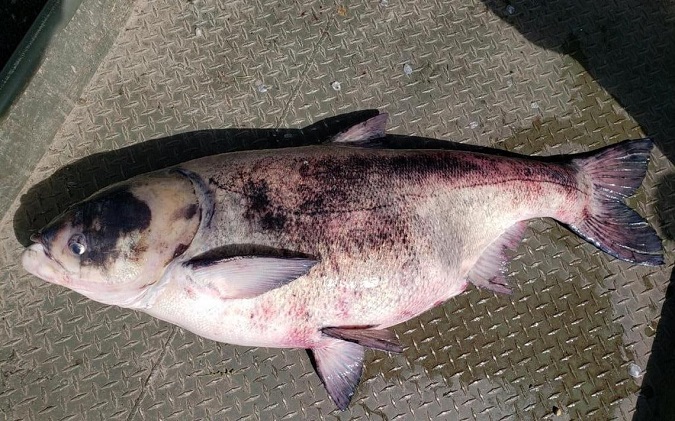
The Minnesota Department of Natural Resources has confirmed the capture of a bighead carp (pictured above) and two silver carp, and detection of a third, tagged silver carp, within the past several weeks. The bighead carp was captured at the Xcel Energy King Power Plant in Oak Park Heights. All of the silver carp were in Pool 4 of the Mississippi River between Red Wing and Wabasha in southeastern Minnesota.
“The DNR has confirmed between two and seven individual invasive carp captures each spring since 2013,” said DNR invasive fish coordinator Nick Frohnauer. “It is unusual that several of a single species would be captured in a short span of time. But, given the persistent high water this spring, this is not a surprise.”
Frohnauer noted that while the DNR continues to be very concerned about the potential impacts of invasive carp in Minnesota waters, individual adult fish captures do not indicate reproduction or an established population of invasive carp in the Mississippi River or elsewhere in the state.
Persistent high water in southern Minnesota, Iowa and Illinois has created “open river” conditions in which fish can move upriver unimpeded by locks and dams. Open river conditions can benefit native species like lake sturgeon and paddlefish, which can swim hundreds of miles in search of preferable habitat. These conditions also allow other, non-native species to move upriver more easily.
A DNR telemetry array detected a silver carp in Pool 4 that was originally tagged much farther south, in Pool 16, in April 2017 by the U.S. Geological Survey (USGS). A silver carp was caught by an angler in Pool 4 May 24, and another was captured in Pool 4 June 4 by Xcel Energy. The bighead carp was captured on Thursday, June 20 during routine monitoring conducted by the DNR.
Background
Fish telemetry in Minnesota started as a small system to better understand fish passage at Lock and Dams 1 and 2 in the Twin Cities. The DNR expanded the system farther downstream and into the Minnesota and St. Croix rivers, to better understand fish movements in Minnesota’s big rivers. The U.S. Fish and Wildlife Service (USFWS) then connected Minnesota’s array with a Missouri array at Lock and Dam 19, in Keokuk, Iowa, in the southeastern part of the state. This Upper Mississippi array has been valuable in understanding large-scale movements of native fish and movement patterns of invasive carp.
In 2018, the USFWS provided funding for a dedicated invasive carp tracking crew to enhance Minnesota’s telemetry project. This crew will work to find the invasive carp detected by the telemetry array. If the fish is located in Minnesota waters, the DNR will work with the USFWS and USGS to deploy nets and other sampling methods in the location of detection.
Invasive carp have been progressing upstream since escaping into the Mississippi River in the 1970s. These large fish compete with native species and pose a threat to rivers and lakes. No breeding populations have been detected in Minnesota waters. Individual invasive carp have been caught as far upstream in Mississippi River Pool 2 near the Twin Cities (bighead, grass, and silver), the King Power Plant on the St. Croix River by Oak Park Heights (bighead), and just downstream of Granite Falls in the Minnesota River (bighead).
The DNR Invasive Species Program has built partnerships with state and federal agencies, conservation groups, university researchers and commercial businesses to prevent the spread of invasive carp. The 2015 closure of the Mississippi River lock at Upper St. Anthony Falls in Minneapolis was a major accomplishment of these efforts.
The DNR is actively engaged with several prevention efforts.
- The DNR is an active partner in the Upper Mississippi River Invasive Carp Workgroup. The group includes representatives from Minnesota, Wisconsin, Iowa, Illinois, Missouri, and several federal agencies.
- In partnership with the DNR, the Minnesota Aquatic Invasive Species Research Center at the University of Minnesota is testing and evaluating carp deterrents in Mississippi River locks and dams. Previously, they had installed and evaluated a speaker system at Lock 8. Development of this technology will continue this year with the installation of an updated speaker system at this location.
- The DNR’s Fish and Wildlife Division leads a comprehensive sampling program to monitor fish population changes and impacts of management actions. This includes maintaining important relationships with commercial fishers and the angling public.
State funding sources, including the Environmental and Natural Resources Trust Fund and Outdoor Heritage Fund, have provided key funding for deterrent actions and the DNR invasive carp detection and response program.
Invasive carp captures must be reported to the DNR immediately. Call 651-587-2781 or email invasivecarp.dnr@state.mn.us. Take a photo and transport the carp to the nearest DNR fisheries office or make arrangements for it to be picked up by a DNR official.
For more information about invasive carp in the United States and in Minnesota go to mndnr.gov/invasive-carp.
